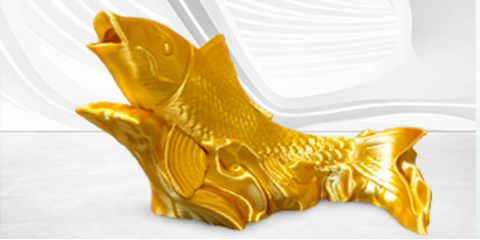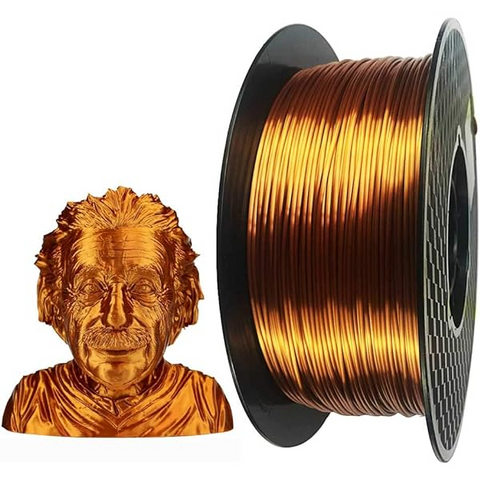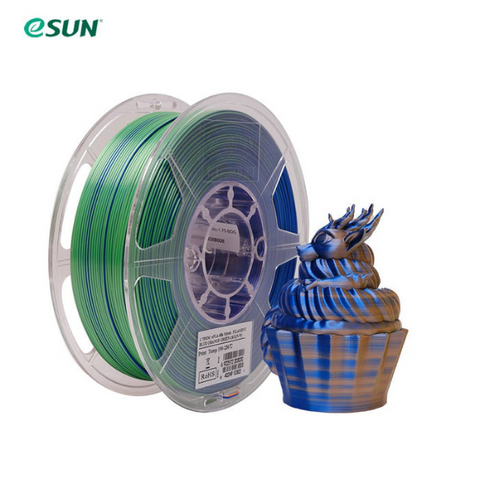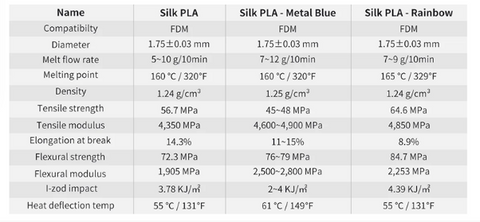When it comes to 3D printing, choosing the right filament is crucial for achieving high-quality results. One type of filament that is gaining popularity among 3D printing enthusiasts is SILK PLA(PLA Plus).

SILK PLA(PLA Plus) filament provides a unique combination of high luster and a smooth, shiny finish, making it ideal for creating eye-catching prints. However, with so many options available, finding the best SILK PLA(PLA Plus) filament for your projects can be a daunting task.
The importance of choosing the right filament
First and foremost, the quality of your filament directly impacts the final outcome of your prints. High-quality SILK PLA(PLA Plus) filaments are known for their excellent layer adhesion and smooth finish, resulting in professional-looking prints with intricate details. On the other hand, low-quality filaments may have inconsistencies in color, texture, or diameter, leading to poor print quality and wasted time and materials.

Moreover, using the right SILK PLA(PLA Plus) filament can optimize the performance of your 3D printer. Professionals and hobbyists alike understand the significance of using filaments that are compatible with their specific printers. This ensures that the filament flows smoothly through the printer's extruder, preventing clogs or filament jams and reducing the risk of wasting filament or damaging the printer.
While premium filaments may come with a higher price tag, they often offer better durability and reliability, resulting in fewer failures and reprinting. Investing in high-quality filaments can save you both time and money in the long run.
Factors to consider when selecting a SILK PLA(PLA Plus) filament

1. Filament Diameter: The diameter of the filament is a crucial factor that directly affects the quality of your prints. Most 3D printers are designed to work with a specific filament diameter, so be sure to check your printer's specifications before purchasing. Common diameters for SILK PLA(PLA Plus) filaments are 1.75mm and 2.85mm.
2. Print Temperature: SILK PLA(PLA Plus) filaments have unique temperature requirements for optimal performance. It's essential to choose a filament that has recommended printing temperatures compatible with your printer. Using the wrong temperature can result in poor adhesion, stringing, or even clogs in the extruder.
3. Color Options: SILK PLA(PLA Plus) filaments come in a wide range of vibrant and shimmering colors. Consider your project requirements and choose a filament color that complements your design and brings out the desired aesthetic appeal.
4. Brand Reputation: Research the reputation and customer reviews of different filament brands. Look for brands known for their consistent quality, excellent customer support, and reliable performance. This will ensure that you invest in a SILK PLA(PLA Plus) filament trusted by professionals and hobbyists alike.
5. Price and Value for Money: While cost shouldn't be the sole deciding factor, it's essential to consider the price of the filament in relation to its quality and performance. Compare prices of different brands and assess their value for money based on factors such as filament consistency, print quality, and durability.
By taking these factors into account, you can make a well-informed decision when selecting a SILK PLA(PLA Plus) filament for your 3D printing projects. In the next section, we will outline some popular SILK PLA(PLA Plus) filament brands that are known for their superior quality and performance, helping you narrow down your options. Stay tuned!
Top brands and options in the market
In this section, we will explore some of the top SILK PLA(PLA Plus) filament brands available in the market. These brands have gained a reputation for their exceptional quality and performance, making them a preferred choice among 3D printing enthusiasts.

1. CC3D SILK PLA(PLA Plus) Filament: Known for its vibrant and shimmering colors, CC3D offers a wide selection of SILK PLA(PLA Plus) filaments. Their filaments are renowned for their consistency and smooth printing experience.

2. Sunlu SILK PLA(PLA Plus) Filament: Sunlu is a trusted brand among 3D printing enthusiasts, and their SILK PLA(PLA Plus) filaments are no exception. With a range of colors to choose from, Sunlu filaments provide excellent adhesion and produce stunning prints.

3. eSUN SILK PLA(PLA Plus) Filament: eSUN is a popular choice for SILK PLA(PLA Plus) filaments due to its wide color palette and excellent print quality. Their filaments have a smooth texture and produce prints with a mesmerizing silk-like finish.
Remember to consider factors such as filament diameter, print temperature, and customer reviews when selecting a SILK PLA(PLA Plus) filament from these top brands.
Customer reviews and experiences

When it comes to choosing the best SILK PLA(PLA Plus) filament for your 3D printing projects, customer reviews and experiences play a significant role in helping you make an informed decision. Hearing what other users have to say about a particular brand or product can provide valuable insights into its overall performance and reliability.
Take the time to read through customer reviews and look for patterns or common themes. Pay attention to comments about print quality, color vibrancy, and filament consistency. Positive reviews that highlight a filament's ease of use, minimal clogging, and excellent adhesion are indicators of a high-quality product.
On the other hand, take note of any negative reviews and consider the reasons behind them. If multiple customers have experienced issues such as poor print quality or inconsistent diameter, it may be wise to steer clear of that particular brand.
Tips for successful 3D printing with SILK PLA(PLA Plus) filament
Now that you have a better understanding of how customer reviews can help you choose the best SILK PLA(PLA Plus) filament, let's delve into some tips to ensure successful 3D printing with this material.

1. Optimize your printer settings: SILK PLA(PLA Plus) filaments often require slightly different settings compared to regular PLA. Experiment with temperature, print speed, and cooling to achieve the desired results. Start with the manufacturer's recommendations and adjust as needed.

2. Use a compatible nozzle: SILK PLA(PLA Plus) filaments may have special requirements when it comes to nozzle diameter. Check the manufacturer's guidelines to ensure you are using the right nozzle for optimal printing.
3. Clean your print bed: Proper adhesion is crucial for successful 3D printing. Before each print, make sure your print bed is clean and free from any residue that may interfere with adhesion. Consider using a suitable adhesive, such as glue stick or hairspray, if needed.
4. Pay attention to filament storage: SILK PLA(PLA Plus) filaments are often more susceptible to moisture absorption than regular PLA. Store your filaments in a dry and airtight container to maintain their quality.
By following these tips, you can maximize the potential of your SILK PLA(PLA Plus) filament and achieve beautiful, high-quality prints for your 3D printing projects.
Conclusion and final recommendations
When choosing the best SILK PLA(PLA Plus) filament for your 3D printing projects, it is important to consider the quality and reputation of the brand. Look for well-established brands that have positive customer reviews and a track record of producing high-quality filaments.
Additionally, pay attention to the color options available. SILK PLA(PLA Plus) filaments come in a wide range of vibrant and metallic colors, so choose a brand that offers the colors that align with your project requirements.
Lastly, consider the price point. While it is tempting to go for the cheapest option available, remember that quality often comes with a slightly higher price tag. Investing in a reputable brand will ensure that you get consistent printing results and avoid any frustrations down the line.
FAQs
1. What makes SILK PLA(PLA Plus) filament different from regular PLA?
SILK PLA(PLA Plus) filament offers a unique combination of high luster and smooth, shiny finishes, setting it apart from standard PLA filaments. This results in eye-catching prints ideal for projects requiring a visually appealing, silk-like surface. Unlike regular PLA, SILK PLA(PLA Plus) filaments are known for their excellent layer adhesion, smooth finish, and professional-looking prints that showcase intricate details.
2. How do I choose the best SILK PLA(PLA Plus) filament?
Choosing the right SILK PLA(PLA Plus) filament involves considering several factors: the filament's diameter to match your printer's specifications, recommended print temperatures, the range of color options to suit your project, the brand's reputation for consistency and quality, and the overall value for money. It's also beneficial to consult customer reviews for firsthand experiences regarding print quality and filament reliability.
3. Can the wrong SILK PLA(PLA Plus) filament affect my 3D printer's performance?
Yes, using a filament that is not compatible with your 3D printer can lead to issues such as clogs, filament jams, and suboptimal print quality. High-quality SILK PLA(PLA Plus) filaments are designed to flow smoothly through the printer's extruder, enhancing the printer's performance and reducing the risk of filament waste or printer damage.
4. Are there any specific tips for printing with SILK PLA(PLA Plus) filament?
For successful 3D printing with SILK PLA(PLA Plus) filament, it's essential to optimize printer settings, including temperature, print speed, and cooling, based on the filament's requirements. Using a compatible nozzle and ensuring the print bed is clean and adequately prepared for adhesion can also contribute to better print outcomes. Additionally, proper storage of SILK PLA(PLA Plus) filament in a dry, airtight container is crucial to prevent moisture absorption and maintain filament quality.
——————————————————

